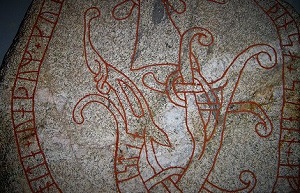 What did it feel like for Vikings to have the Younger Futhark as an alphabet in the Viking Age? Imagine you have your standard English alphabet. Then you have a reform based on the fact that the writing system is exceedingly complex and the letters are too many. Let us cut down their number, they say, it will be fun, they say. There are many sounds that really sound in a very similar way, let us have only one symbol for the two! Let us write p for both p and b (let us abolish b altogether), t for both t and d (we don’t really need d, do we?), k for k, g and ng (we know you never liked g and ng), f for both f and v (despite v being the sign of victory), u for both u and o (they do sound the same), i for both i and e (we don’t think this will be a problem after we’ve done what we have). Just look how wonderful our new writing system is:
What did it feel like for Vikings to have the Younger Futhark as an alphabet in the Viking Age? Imagine you have your standard English alphabet. Then you have a reform based on the fact that the writing system is exceedingly complex and the letters are too many. Let us cut down their number, they say, it will be fun, they say. There are many sounds that really sound in a very similar way, let us have only one symbol for the two! Let us write p for both p and b (let us abolish b altogether), t for both t and d (we don’t really need d, do we?), k for k, g and ng (we know you never liked g and ng), f for both f and v (despite v being the sign of victory), u for both u and o (they do sound the same), i for both i and e (we don’t think this will be a problem after we’ve done what we have). Just look how wonderful our new writing system is:
Whin in thi Cuursi uf human ifints, it bicumis nicissary fur uni piupli tu tissulfi thi pulitical bants which hafi cunnictit thim with anuthir, ant tu assumi amuk thi puwirs uf thi iarth, thi siparati ant iqual statiun tu which thi Laws uf Naturi ant uf Naturi’s Kut intitli thim, a ticint rispict tu thi upiniuns uf mankint riquiris that thiy shuult ticlari thi causis which impil thim tu thi siparatiun.
If you were unable to read it right away, I will help you a little: it is the beginning of the United States Declaration of Independence. Now you have the idea of what Vikings felt when they exchanged the Elder Futhark, which had 24 runes, for the Younger Futhark, which had only 16. Now try to read this:
A pik pik piks for a pik.
Hint: pik pik is not a bird sound. The first pik is related to a notion of dimention. The other one points to an animal. Try to decypher the rest yourself. Share your readings in the comments below. Suggest your own funny phrases that would be difficult to read in the Younger Futhark runes.
Photo courtesy Insidious and subtle M. Used under Creative Commons Attribution-NonCommercial 2.0 Generic Licence.

Best I can do is, “A big pig begs for a peg.”
This is clearly an issue when using the Younger Futhark to write in English.
Did it create the same issue in Old Norse?
The vikings didn’t speak modern English so it’s not an accurate representation of how the change from Elder to Younger Futhark may have impacted vikings.
I’m very interested to know if it did.
The proliferation of rune stones written in Younger Futhark makes me think the reduction in characters isn’t a problem if you’re using the language they’re intended for. But I don’t know Old Norse at all. So I’m just assuming.
Happy to hear from anyone with a greater understanding.
Thanks
Proliferation is not the word to describe it. Runes were used for short commemorative inscriptions, containing mostly names. Whether or not it was convenient to write, for example, uaurþr for what is written vǫrðr in Latin alphabet (runic inscription U 617), is more or less obvious. Runic texts longer than a few sentences are extremely rare.